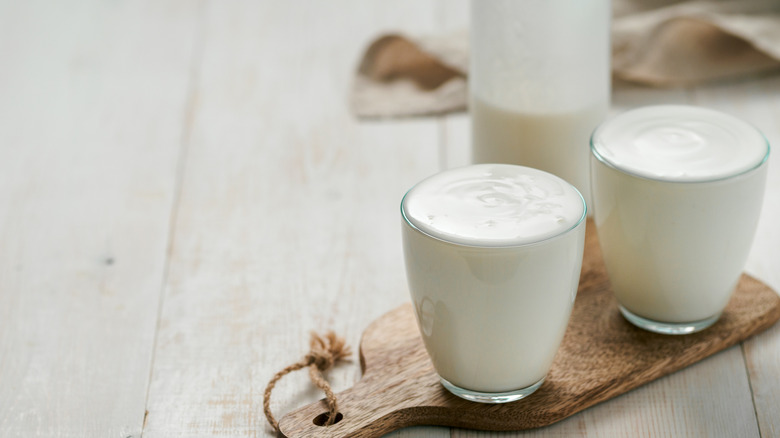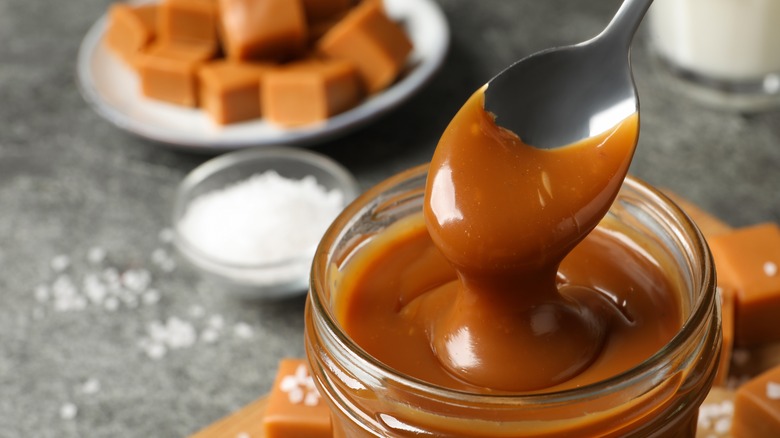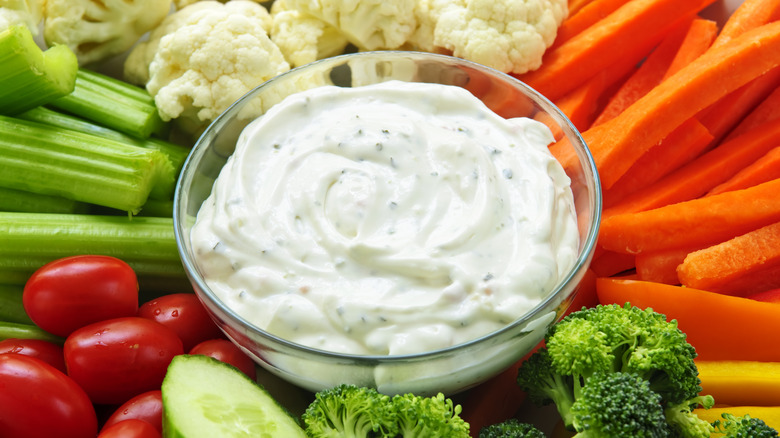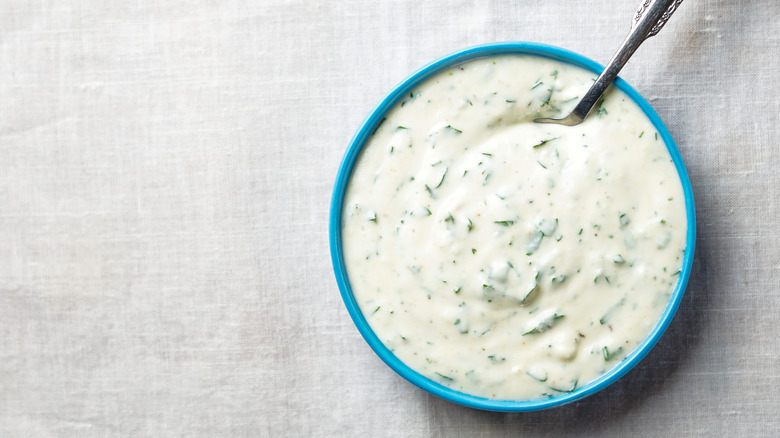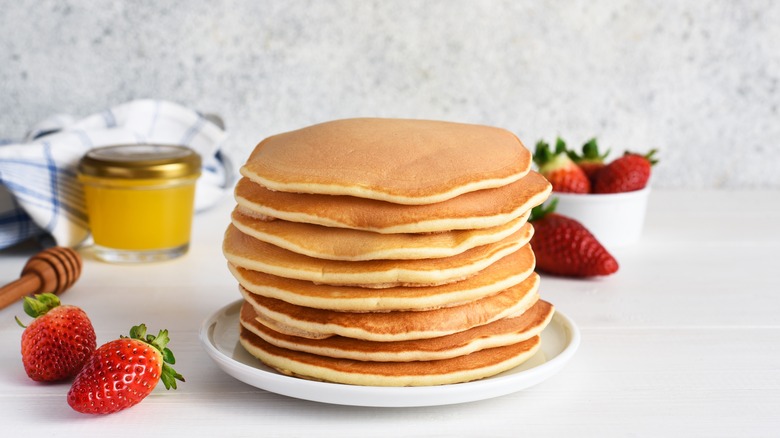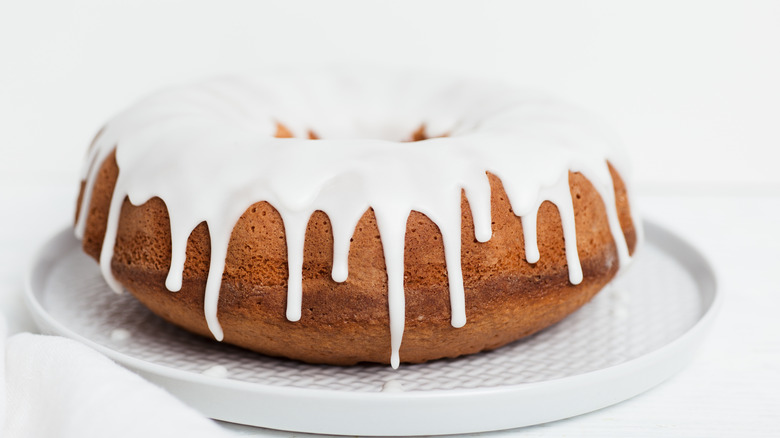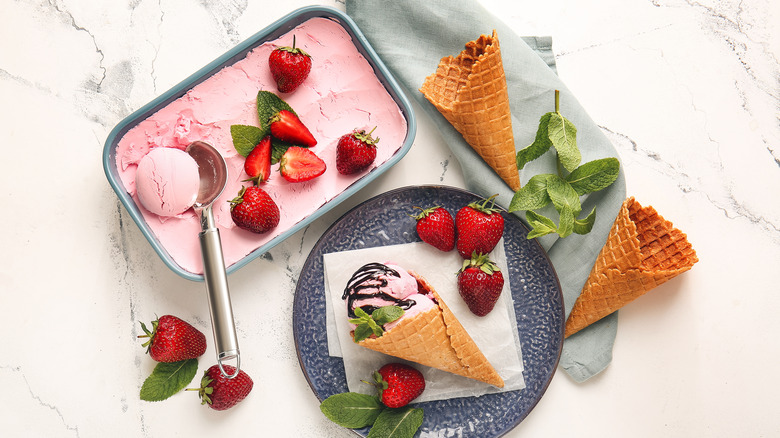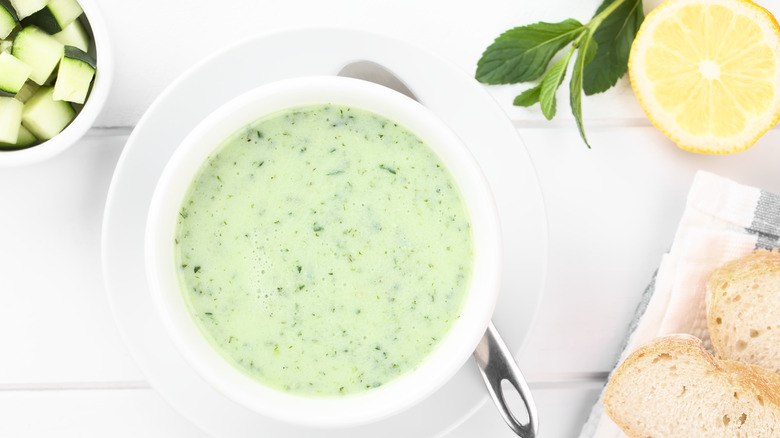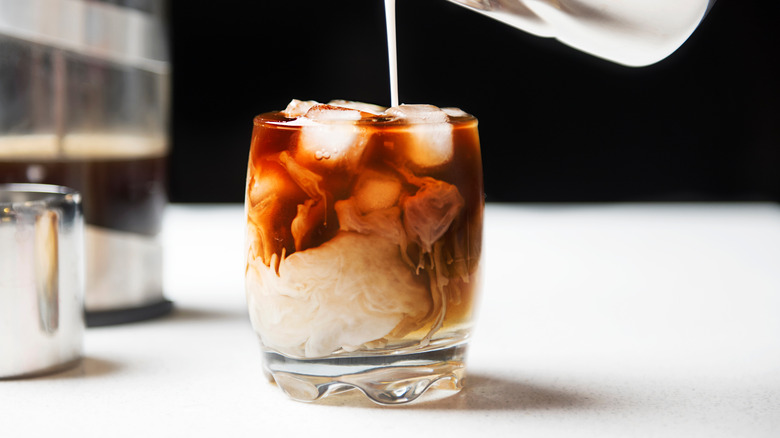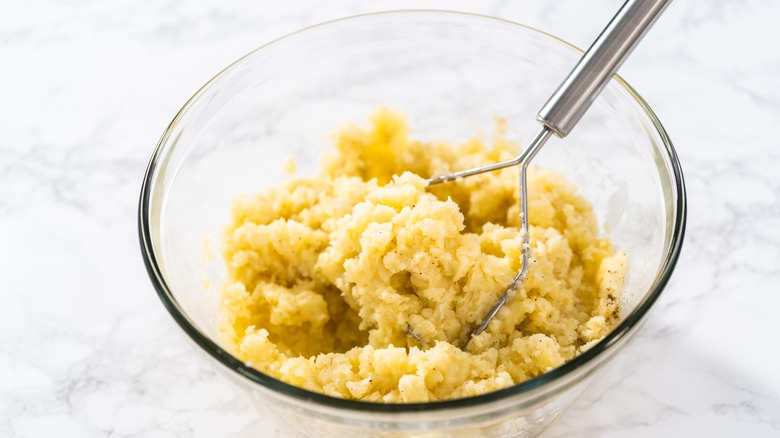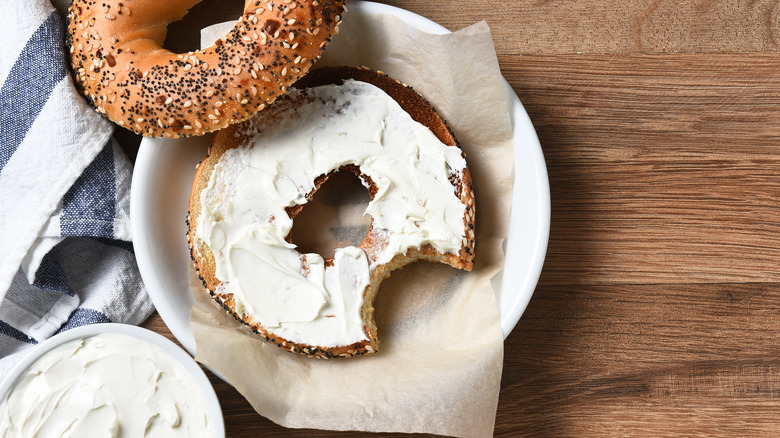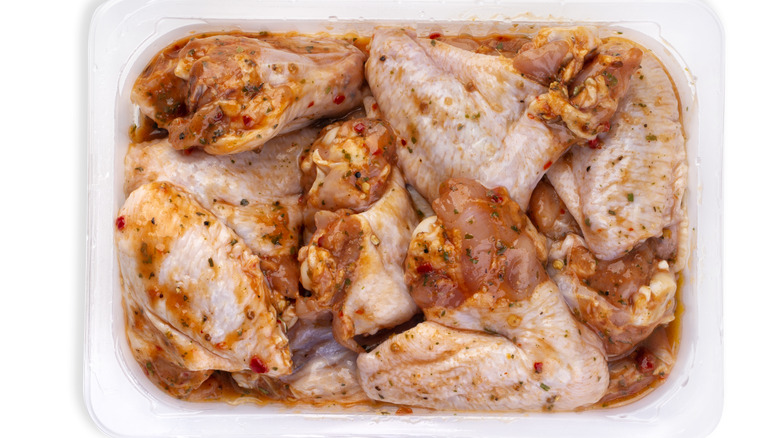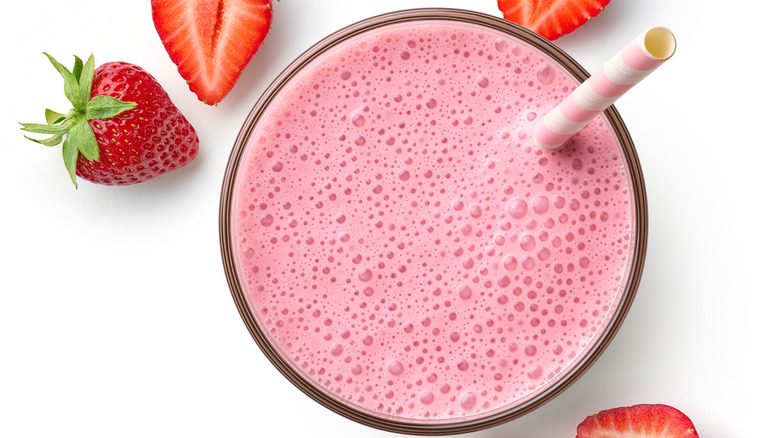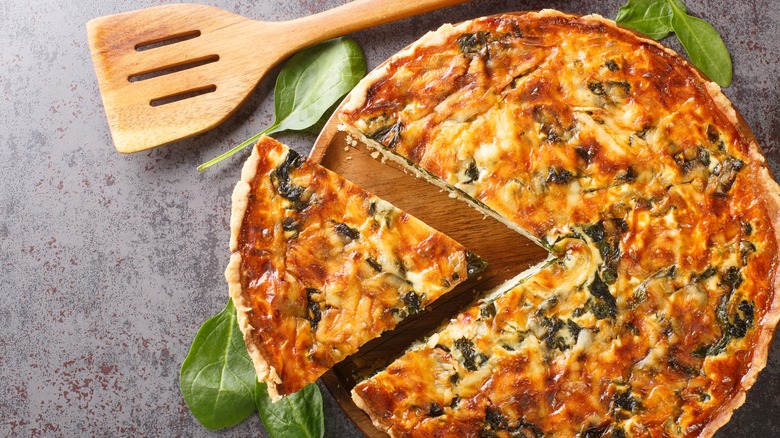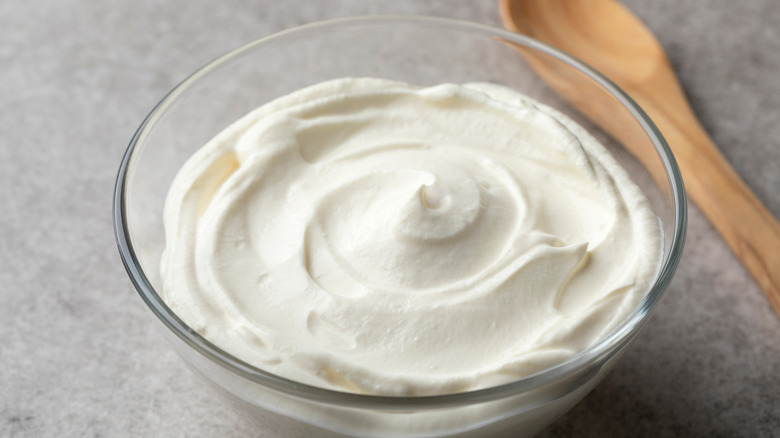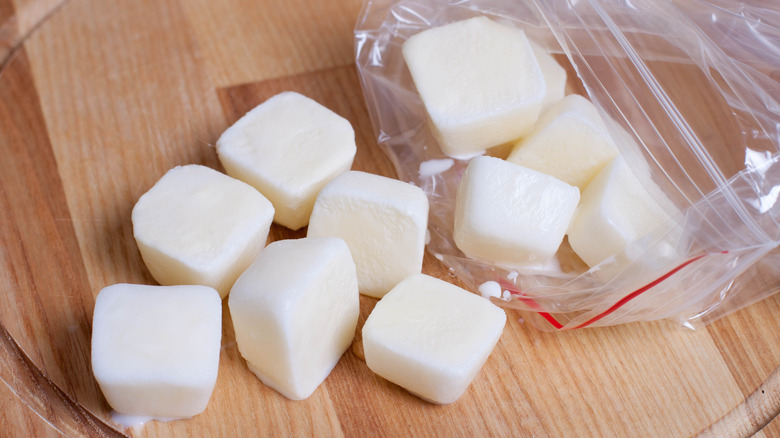16 Ways To Use Leftover Buttermilk
Buttermilk is a type of milk that is made by culturing fresh cow's milk. Adding a bacterial culture causes the milk to ferment and thicken, giving it a tangy flavor. Traditionally, this milk was made from the by-product of churning butter. The cultured milk would separate into butter and whey, and that whey came to be called "buttermilk." Today, butter is no longer made with cultured cream so buttermilk is made separately by adding a specific type of bacteria to pasteurized milk.
The creamy, tangy addition tends to be one of those ingredients that requires a special trip to the store, and it never fails that you go to whip up a batch of buttermilk pancakes or biscuits and end up with some leftovers. Since buttermilk typically has an expiration date of about two weeks in the refrigerator, it becomes a common conundrum for the home baker. How to use up those leftovers? The good news is there are plenty of ways to take advantage of that extra buttermilk.
Replace cream in caramel sauce
Delicious, salted caramel sauce is one of the best treats in all the wide world of baking and pastry. Caramelized sugar on its own will solidify and harden, but adding a bit of butter or cream (or sometimes both) leaves the mixture in a permanent liquid state, perfect for drizzling on ice cream or sandwiching between cookies. Most caramel sauce recipes call for just a bit of cream, usually around ¼ cup.
If you have buttermilk left over, try adding it to a batch of caramel. It will still impart the same velvety texture as cream, but with an added note of tangy tartness. Using this liquid in caramel is as simple as just swapping the amount of cream the recipe calls for in an even amount. Typically, the recipe will also call for butter and you should still leave that in. Buttermilk tends to be lower in fat than cream so the sauce will need the butter to keep its richness.
Make a dip for chips and veggies
Buttermilk is a common ingredient in dip recipes of all kinds because it adds a tangy flavor and slightly thick consistency. To make a great dip with buttermilk, simply combine buttermilk with other ingredients, such as herbs, spices, vegetables, or cheese, and mix well. You can then serve the dip immediately, or chill it in the refrigerator for a few hours to allow the flavors to develop. Some examples of dips that can be made with buttermilk include blue cheese dip and onion dip. A buttermilk ranch dressing is the perfect pairing for your crudité.
Consider swapping in buttermilk if a dip includes some type of milk or cream. In most cases, the dairy addition called for in the recipe can be freely substituted with buttermilk. All dips need something thick to keep the consistency right for dipping, so when in doubt, just add a little at a time and go from there.
Whip up a creamy salad dressing
Just like with dips, buttermilk is a common ingredient in salad dressings. When you find yourself with just a bit of buttermilk leftover, consider whipping up a simple buttermilk peppercorn dressing. If it happens to be steak night, a classic wedge salad with buttermilk dressing is an ideal starter. Most dressing recipes ask for somewhere around a cup of buttermilk, but any recipe can always be halved to accommodate the amount of buttermilk you have to use up.
Unlike vinaigrettes, dressings that use buttermilk can rely on the creaminess of this liquid to emulsify the sauce. That means there is no whisking or blending required; a simple but vigorous stir should do fine. The best addition to buttermilk dressings is always going to be fresh herbs, so don't be afraid to spring for fresh chives, parsley, or dill (or all three!).
Bake biscuits, muffins, cake, or bread
Many people find themselves with leftover buttermilk from some kind of baking, so it comes as no surprise that one solution to using up the remaining buttermilk from these recipes would be, you guessed it, more baking. There is a whole wide world of baking recipes that call for buttermilk in all kinds of various amounts, from buttermilk cornbread to blackberry buttermilk bundt cake to a zesty lemon buttermilk pound cake. The amount of leftover buttermilk you need to use up will ultimately determine which recipe will work best for you.
The best part about using leftover buttermilk in baked goods is that those items can then be frozen for several months until you are ready to serve. This way, if you don't have an immediate need for the cake or other baked good, you can always keep it in the freezer and ready to thaw for that uninvited guest or unexpected party.
Upgrade pancakes or French toast
Maybe it goes without saying, but leftover buttermilk can always be used to make a perfect batch of fluffy pancakes. It is the not-so-secret ingredient that not only adds a delicious flavor to the floury sweetness of pancakes, but the acidity in the buttermilk also activates with the other chemical leaveners (usually baking soda) to make those pancakes as light and fluffy as possible.
Other than pancakes, buttermilk can also be added to the milk mixture in French toast recipes. You can substitute either wholly or in part depending on the amount of sour flavor you want to inject into your French toast and how much buttermilk you have to use up. This option might be the way to go over pancakes if you only have a few tablespoons or less than a cup remaining. Either way, it's all going to taste great covered in maple syrup.
Create a buttermilk glaze
One of the better uses for a small amount of leftover buttermilk (like a couple of tablespoons) is in a glaze. A standard issue glaze is made mostly of powdered sugar, along with a small amount of melted butter or milk. The liquid component can be substituted with just a small splash of buttermilk. If it ends up too runny, simply add more powdered sugar until it's the consistency you are looking to achieve.
This type of glaze often shows up on old-fashioned donuts or sweet and buttery pound cakes. It can also be quite tasty on cookies, scones, muffins, or any number of other baked goods. Ultimately, this use for buttermilk will depend on your schedule since not everyone will have the time to whip up a whole batch of some baked good just to use up a few tablespoons of buttermilk. However, if you already have plans for some baking, it could be a good option.
Churn some creamy ice cream
Ice cream is the heavenly combination of dairy, sugar, and eggs, mixed while being simultaneously frozen to create one of the most delicious and popular desserts of all time. Old-fashioned ice cream would have been made with cultured cream as that was more commonly found at the time. To recall some of that nostalgic flavor, buttermilk can be added to ice cream before churning to impart some tart flavor.
Ice cream recipes are notoriously tricky, and messing with the ratios of fat to sugar to liquid can cause icy crystals to form. The best practice if you aren't familiar with creating ice cream recipes from scratch would be to start by substituting just a few tablespoons of buttermilk for milk. This trick works especially well with fruit-flavored ice creams, like strawberry or peach. Even chocolate ice cream will taste good with a little buttermilk added to the base.
Make a soup
Perhaps one of the most surprising ways to use up leftover buttermilk is in a soup. Buttermilk can be used in soups similar to as you would in yogurt, simply adding a slight tangy flavor, or as the main ingredient, like this Danish buttermilk soup. In most cases, buttermilk works best in chilled soups, like watercress or vichyssoise. For these types of recipes, it's best to start small when adding in buttermilk. Remember the old culinary rule: It's always easier to put more of something in than it is to take it back out.
For hot soups, adding buttermilk can be even easier. Most hot soups will benefit from a little tart and tangy creaminess, so a small drizzle of buttermilk as a garnish can be a great way to use up a tiny amount of buttermilk. Most soups will only need about a tablespoon to get the flavor of the buttermilk, though more often won't hurt.
Pour into a hot cup of coffee
It is a question that many have likely wondered but probably never tried. Can you add buttermilk to coffee? The short answer is: yes. Buttermilk is simply milk with active cultures added to it, and can easily be added to coffee in place of milk or half-and-half. The texture of buttermilk is much thicker than regular whole milk, so it is probably a good idea to start with a small amount and taste before adding more.
Iced or hot, coffee has a robust and rich flavor that many find is complemented by a healthy splash of either dairy or non-dairy milk. This could be potentially problematic for some, as this combination doesn't always feel so good in the stomach. The probiotics in buttermilk may help aid the digestion of both the coffee and the dairy, so feel free to try it next time you have a bit on hand.
Add a tangy note to mashed potatoes
After making a big batch of whatever baked good your buttermilk was initially intended for, even the most energetic bakers may find themselves a little fatigued. Making yet another thing is sometimes just not in the cards, which is probably why so much leftover buttermilk probably ends up in the trash. For a super-simple use for buttermilk that requires no recipe, try just adding it to a batch of mashed potatoes. Just like adding sour cream to mashed spuds, the tartness from cultured dairy is the perfect thing to liven up a big bowl of potatoes laden with rich butter.
Adding a little buttermilk to mashed potatoes couldn't be easier. Simply add a splash and then taste. Not tasting it enough? Add some more. The total amount used will depend on the amount of potatoes and other ingredients, but even a small splash will add a quick boost of flavor.
Enjoy homemade buttermilk cream cheese
Most people smear their bagels with cream cheese without a second thought to how it's made. After all, it comes packaged so ready to be spread upon fluffy baked goods. The intrepid few may have considered making their own cream cheese at home, which can be lighter, fluffier, and creamier than the store-bought varieties. The best kinds of cream cheese have a delightfully tangy flavor and buttermilk is often at work here, and making a homemade batch of buttermilk cream cheese is an excellent way to use it up.
Homemade cream cheese is made with just a few ingredients (milk, cream, salt, and rennet) and a little bit of time and energy. You only need a couple of tablespoons of buttermilk to inject your cream cheese with that tantalizing tartness, so this could be a great option if you only have a tiny bit of buttermilk leftover.
Marinate chicken
One of the most common ways buttermilk gets used as an ingredient is for buttermilk fried chicken, though the amount you need for that recipe is likely more than you might have on hand leftover from something else. The buttermilk adds acidity to the chicken and helps to tenderize it, as well as acting as a vehicle for spices and salt, which make their way into the chicken via osmosis. Even if you only have a bit of leftover buttermilk, you can still include it as an ingredient in a marinade for smaller batches of grilled or roasted chicken tenders or thighs.
There's not really an exact amount necessary for a buttermilk marinade. You can start with simply adding a few tablespoons to an existing marinade recipe that you already like. Just keep in mind the existing amount of acidity from citrus or vinegar that may be in the recipe before adding, as buttermilk will bring its own kick.
Add a protein boost to smoothies
Buttermilk contains about the same amount of protein per cup as regular, whole milk (via the USDA), and both can be excellent ingredients to add to fruit smoothies to get an added boost of protein in your daily intake. Buttermilk has the same added benefit of active cultures as yogurt or kefir, all of which may contribute to better digestion. All of these probiotics are made up of a combination of the good bacteria that our bodies need to fight off disease-causing bad bacteria.
When adding buttermilk to a smoothie, the proportions stay the same as any other liquid. Most smoothie recipes call for a cup or two of liquid in the form of milk or juice, but if you don't have that much leftover buttermilk just go for a combo. Even a few tablespoons of buttermilk added to a smoothie will impart some of the benefits of the active cultures.
Take quiche to the next level
Quiche is the MVP at most brunches. A delicious combination between frittata and savory pie, a quiche features a mixture made with eggs, milk, cream, and cheese poured into a flaky pie crust and baked until golden brown on top. Quiche can also be filled with all kinds of breakfast meats, like ham or bacon, as well as tasty vegetables like melted leeks, sauteed spinach, or even fresh herbs.
All these rich ingredients can use something acidic to balance the flavor. Enter buttermilk, a great addition to any quiche. Even if you only have a few tablespoons, substituting some of the milk or cream for a little buttermilk can enhance the flavor of the whole dish and bring out the flavors of the cheese and other ingredients. Using more than about a cup might mess with the texture, so stick to small amounts when substituting.
Make homemade crème fraîche
Crème fraîche is the slinky black dress of the culinary world and the cultural predecessor to sour cream. It used to be difficult to find in the United States due to food regulations so many chefs and restaurants had to resort to making it themselves. Even though commercially made pasteurized crème fraîche can now be found some grocery stores, the option to make it at home is still available. In fact, crème fraîche is much easier to make than you might think.
Since buttermilk already contains the active bacteria needed to culture the cream, a few tablespoons stirred into some heavy cream is enough to get the process started. After that, it's simply a matter of leaving the mixture at room temperature for about 24 hours until it has thickened into crème fraîche. Incorporate it anywhere you might use sour cream, from topping enchiladas to garnishing a soup to serving with blinis and caviar.
Freeze buttermilk to use later
While there are many uses for leftover buttermilk, one way to buy yourself some time is to freeze it. According to the USDA, buttermilk will keep in the refrigerator for two weeks, and can be frozen for up to three months. The best way to freeze buttermilk is in ice cubes or in pre-portioned plastic bags with a label designating the amount inside. That way, when you need to grab some, you know exactly how much you are thawing.
When the buttermilk is frozen, you can remove it from the container and store it in a larger plastic bag or container to save space in your freezer. When you are ready to use the frozen buttermilk, thaw it in the refrigerator and give it a good stir before using it in your recipe. Keep in mind that frozen buttermilk may have a slightly thicker consistency and a more pronounced tangy flavor than fresh buttermilk, so you may need to adjust your recipe accordingly.
